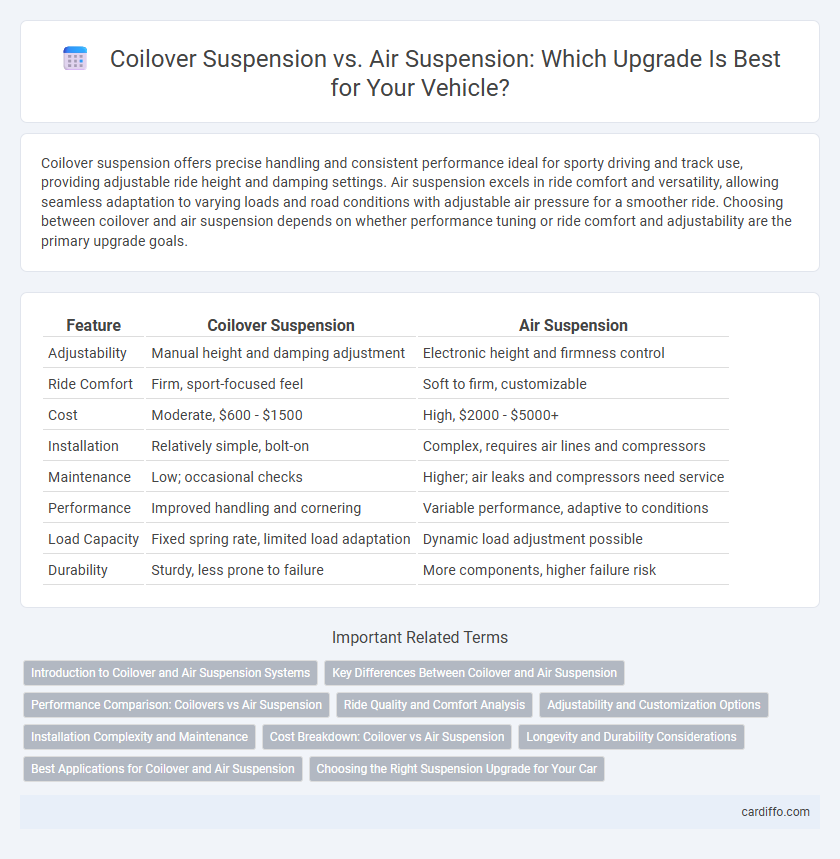Coilover suspension offers precise handling and consistent performance ideal for sporty driving and track use, providing adjustable ride height and damping settings. Air suspension excels in ride comfort and versatility, allowing seamless adaptation to varying loads and road conditions with adjustable air pressure for a smoother ride. Choosing between coilover and air suspension depends on whether performance tuning or ride comfort and adjustability are the primary upgrade goals.
Table of Comparison
| Feature | Coilover Suspension | Air Suspension |
|---|---|---|
| Adjustability | Manual height and damping adjustment | Electronic height and firmness control |
| Ride Comfort | Firm, sport-focused feel | Soft to firm, customizable |
| Cost | Moderate, $600 - $1500 | High, $2000 - $5000+ |
| Installation | Relatively simple, bolt-on | Complex, requires air lines and compressors |
| Maintenance | Low; occasional checks | Higher; air leaks and compressors need service |
| Performance | Improved handling and cornering | Variable performance, adaptive to conditions |
| Load Capacity | Fixed spring rate, limited load adaptation | Dynamic load adjustment possible |
| Durability | Sturdy, less prone to failure | More components, higher failure risk |
Introduction to Coilover and Air Suspension Systems
Coilover suspension systems feature adjustable springs and dampers mounted as a single unit, offering precise control over ride height and handling performance, making them popular for performance and track applications. Air suspension systems use air springs powered by compressors and air tanks, allowing dynamic adjustment of ride height and comfort levels to adapt to varying road conditions and load requirements. Both systems enhance vehicle suspension capabilities, with coilovers emphasizing mechanical precision and air suspensions prioritizing adaptability and ride quality.
Key Differences Between Coilover and Air Suspension
Coilover suspension offers adjustable ride height and improved handling with a fixed spring and shock absorber setup, ideal for performance-focused driving. Air suspension provides customizable ride comfort and adjustable load capacity through air springs, making it suitable for variable driving conditions and luxury vehicles. Key differences include coilovers' mechanical simplicity and stiffness versus air suspension's ability to adapt ride height and damping dynamically for enhanced comfort and versatility.
Performance Comparison: Coilovers vs Air Suspension
Coilover suspension offers superior handling and precise cornering due to its adjustable spring rates and damping settings, making it ideal for performance driving on varied terrains. Air suspension provides unmatched ride comfort and adjustable ride height, enhancing versatility but often sacrificing immediate responsiveness compared to coilovers. For track-focused applications, coilovers deliver better feedback and control, while air suspension excels in daily driving and load adaptability.
Ride Quality and Comfort Analysis
Coilover suspension systems offer precise handling and consistent ride quality by delivering firm support and reduced body roll, ideal for performance-focused driving. Air suspension provides superior comfort through adjustable air springs that adapt to road conditions, enhancing smoothness and reducing vibrations for a plush ride experience. Comparing ride quality, air suspension excels in comfort customization, while coilovers prioritize responsiveness and stability.
Adjustability and Customization Options
Coilover suspension offers precise mechanical adjustability with options to modify ride height, damping, and spring rates, allowing for tailored performance and handling characteristics. Air suspension provides extensive customization through electronic controls that enable on-the-fly ride height adjustments, load leveling, and variable stiffness for comfort or sport modes. Both systems cater to different customization needs, with coilovers excelling in fine-tuning for track use and air suspension prioritizing convenience and adaptability for daily driving.
Installation Complexity and Maintenance
Coilover suspension offers a straightforward installation process with fewer components, making it generally easier to install and maintain compared to air suspension systems. Air suspension requires complex installation involving compressors, air lines, and electronic controls, increasing the potential for mechanical issues and higher maintenance demands. Regular checks of air bags, compressors, and leak detection are essential to ensure the reliability of air suspension, while coilovers need periodic adjustments and inspections of springs and dampers.
Cost Breakdown: Coilover vs Air Suspension
Coilover suspension systems generally cost between $1,000 and $3,000 for parts and installation, offering a more affordable upgrade compared to air suspension, which can range from $3,000 to $8,000 or more due to complex components and electronic controls. Maintenance costs for coilovers remain lower, with occasional adjustments and spring replacements, while air suspension demands higher long-term expenses from compressor repairs, airbag replacements, and sensor calibrations. Choosing coilovers provides a budget-friendly performance boost, whereas air suspension suits buyers prioritizing adjustable ride comfort despite increased initial and upkeep costs.
Longevity and Durability Considerations
Coilover suspension systems typically offer greater longevity and durability due to their robust metal construction and fewer electronic components, making them well-suited for harsh driving conditions and extended use. Air suspension systems rely on airbags and compressors that can wear out over time, requiring regular maintenance and potential replacement of parts, which may affect long-term reliability. When prioritizing durability and lifespan, coilovers generally present a more resilient and low-maintenance solution compared to air suspension setups.
Best Applications for Coilover and Air Suspension
Coilover suspension systems excel in performance-oriented applications such as track racing and aggressive street driving due to their precise handling, adjustable ride height, and improved cornering stability. Air suspension is best suited for vehicles requiring versatile ride comfort and load adaptability, including luxury cars and heavy-duty trucks, as it offers adjustable ride height and smooth damping for varied road conditions. Choosing between coilover and air suspension depends on the need for performance tuning versus comfort and load management in specific driving environments.
Choosing the Right Suspension Upgrade for Your Car
Coilover suspension offers precise handling and adjustable ride height, making it ideal for enthusiasts seeking performance and customization. Air suspension provides superior comfort and the ability to change ride height on the fly, perfect for those prioritizing versatility and smooth driving. Selecting the right suspension upgrade depends on your driving style, desired ride quality, and budget considerations.
Coilover Suspension vs Air Suspension Infographic

 cardiffo.com
cardiffo.com